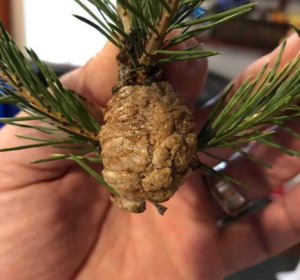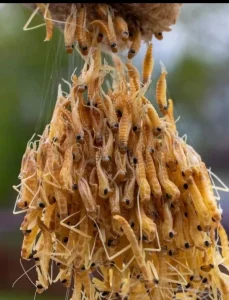One man saw something peculiar in the branches of his newly cut Christmas tree. He had no clue that the harmless-looking group would quickly become popular and cause a big warning. As he leaned in to hang an ornament, he observed something strange and brownish stuck to the bottom of one of the branches. He was fascinated and a little terrified, so he peered at it more attentively. He didn’t find a section of the tree; he found an ootheca, which is a casing for praying mantis eggs.
He was so astonished by what he saw that he put a picture of the egg sac on social media to let other people know about the hidden bug. His message quickly gained a lot of attention because other individuals shared their own stories. The message was clear: if you buy a real Christmas tree during the holidays, you might be bringing more than just pine needles into your home.

The egg cases of praying mantises are naturally camouflaged and can look like tree bark or twigs. These foam-like objects are usually a dull brown or tan color, and they can store up to 200 tiny mantis nymphs that are waiting for the right temperature to hatch. In the late summer or fall, the ootheca is created. If the tree is cut down and brought inside for the holidays, the warm inside air can make the eggs hatch weeks or even months earlier than they should.
Experts believe that a sudden swarm of baby mantises may sound alarming, but they aren’t deadly to people or pets. In fact, a lot of gardeners like praying mantises because they consume other bugs, such aphids and flies. But they won’t live long inside a house and might spread out to look for food and light, which could make cleaning up a little unpleasant (but not harmful).

If you see a praying mantis egg case in your tree, don’t worry. You can gently cut around the ootheca and take the branch off, or you can move it outside. The young mantises will hatch on their own in the spring if you leave the egg case in a safe spot in your yard, like on a bush or a tree limb. This will benefit the environment. Some people even use string or garden twine to tie the egg case to a tree or fence nearby so it stays safe until the weather becomes warmer.
This bizarre story about a holiday reminds us that nature may often get in the way of our most treasured traditions. We sell millions of real Christmas trees every year, and it’s not unusual for animals to live on them. It could be a spider, a praying mantis, or even a little bird’s nest. Take a few more minutes to look over your tree before bringing it inside. This method can help you avoid surprises.

To discourage any six-legged visitors from hatching this season, carefully shake your Christmas tree before bringing it inside. Then, inspect closely at the branches for unusual clumps, sacs, or small creatures. If you follow these simple measures, you won’t have any surprise guests for the holidays, unless you want a few more folks to help with pest control in the spring.
Whether you believe it’s a problem or a small holiday miracle, finding a praying mantis egg case in your Christmas tree is something you’ll never forget, and so will your social media followers.
